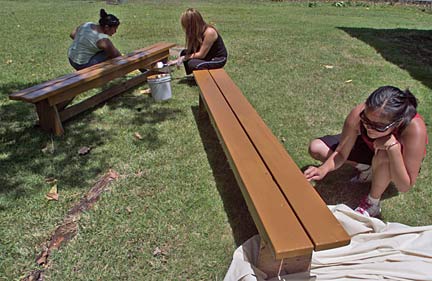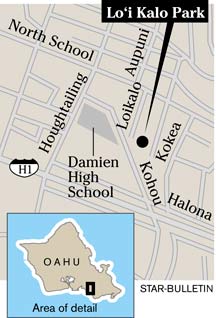
|
Seeds of preservation
Cleanup duty helps students
see treasure in a trashed park
An oasis sits in the middle of Kalihi: a former taro patch that is more a pond with grassy area, trees and pavilion marred by vandals.
Into this 3-acre park steps Michael Leong and the Friends of Lo'i Kalo to keep it from being destroyed.
It was once part of Foster Botanical Gardens and then the city Parks Department. Liliuokalani Center adopted it in 1996 to use as a botanical classroom, a place for hula halaus to meet, for family picnics and cultural reflection. The park is planted almost entirely with native Hawaiian plants.
Leong hopes to grow taro in the lo'i, or taro patch, once again. He and Nani Naope, Liliuokalani Center Hawaiian Studies teacher, said the lo'i was ancient, but did not say how old.

Liberty Trajano, Helen Park and Kathleen Jose helped paint benches at Lo'i Kalo Park yesterday as part of a college-sponsored study course.
![]()

"This is a special place," Leong said.
The park was once just a dumping ground for trash, Leong said. But now neighborhood problems occur with people drinking alcohol at night or urinating or defecating in the park, Leong said. The city once installed portable toilets, but they were removed four years ago because of complaints about evening drinking and the cost of maintenance.
Yesterday, a group of 20 students taking a summer travel study course sponsored by the University of California at Los Angeles spent a few hours scrubbing and painting over graffiti, clearing tree branches and giving tables and benches a new coat of paint. They were part of an Asian-American studies class that UCLA professor Rod Labrador has brought to the park the last several years for community service and education.
One of his students, Julius Toledo, who has worked with underprivileged youths in Los Angeles, looked at the chance to clean up the lo'i as "a golden opportunity" because "our parks aren't like this. ... There's a lot of sacredness here. It's very, very humbling."
He said L.A. parks are "not as respected. People don't take the initiative to clear up the mess. It's something we hardly every see. In L.A. they could (not) care less."
Naope, who has taught classes visiting the park for six years, led the students in a chant acknowledging the ancient Hawaiians who lived here and asking their permission to enter.
She said there is a need to observe this protocol because the lo'i is "one of the few places left like this."
E-mail to City Desk
[News] [Business] [Features] [Sports] [Editorial] [Do It Electric!]
[Classified Ads] [Search] [Subscribe] [Info] [Letter to Editor]
[Feedback]
